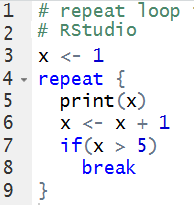

4 Loop break and next functions. 3.2 Creating a clock with a for cycle. 3.1 Bootstrap with the for loop in R. 2.3 Learning with data that are not your own3 Examples of R for loops.
Run A Loop In R Code That Does
Whether there is an alternative R code that does not require loops. The result is a vector VAT that contains, for each client, the correct VAT that needs to be applied.If you want to run a line from the script window, you place the cursor in any place. In each round through the loop, add the outcome of switch () at the end of the vector VAT. For every value in the vector client, apply switch () to select the correct amount of VAT to be paid. 7 Parallel for loop.Create a numeric vector with length 0 and call it VAT.
4.5 Clone your repository using RStudio In the first iteration, the value of i is set to a numeric vector with the same values as the x column in. 3.10.1 I entered a command and nothing’s happeningR starts executing at the top of the for loop.
6.16.1 Error: unexpected SPECIAL in " %>%" 6.7 select() subsets data column-wise (variables) 6.5 filter() subsets data row-wise (observations). 6.3.2 Look at the variables inside a data.frame 6.2.2 load tidyverse (which has dplyr inside) 5.2 Install our first package: tidyverse
9.4 Give your collaborator administration privileges (Partner 1 and 2) 9.3 Create a gh-pages branch (Partner 1) 8.5 Conditional statements with if and else 8.4.1 Thinking ahead: cleaning up our code 7.4 gather() data from wide to long format
In the first if statement we asked for estimated data, and the else condition gives us everything else (which we know is reported). For each item in the country_list, the for loop will iterate over the code within the Note that this works because we know there are only two conditions, Estimated = yes and Estimated = no. 9.6 Clone to a new Rproject (Partner 2)# create a list of countries country_list % filter(country = cntry) # plot my_plot <- ggplot( data = gap_to_plot, aes( x = year, y = gdpPercap)) + geom_point() + # add title and save labs( title = paste(cntry, "GDP per capita", sep = " ")) ggsave( filename = paste(cntry, "_gdpPercap.png", sep = ""), plot = my_plot) }At this point, we do have a functioning for loop.


 0 kommentar(er)
0 kommentar(er)
